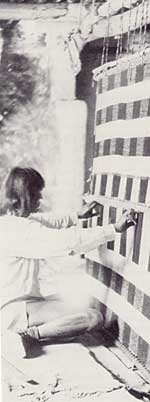History
Culture
Design &
Technique
How
To
Artists
Convocation
Glossary

Home
|
Types of Looms
In the Southwest two types of looms have
been recorded among the Pueblo and Navajo peoples: the backstrap
loom and the upright loom.
|
|
| |
Upright
Loom
In the case of the upright loom
among the Hopi, the lower, or cloth beam is
positioned a
few
inches
above
the floor or ground, and the upper beam is fastened to the
ceiling beams directly above it, so that warps are fixed
at right angles to the floor. Loom poles are six to eight
feet long and 3 inches to 4 inches thick (180 cm to 240 cm
by 7.8 cm to 10 cm). The lower beam may be held down by ropes
passed through anchor loops set permanently into the floor.
Weaving proceeds from the lower beam up. The weaver may unfasten
the entire warp set from the loom beams when about half the
blanket is finished, turn it upside down so that the woven
portion is at the top of the loom, and weave upward to the
center. Alternatively, the weaving area may be kept within
convenient reach by lowering the top warp bar and folding
and fastening the woven portion on itself.
|
|
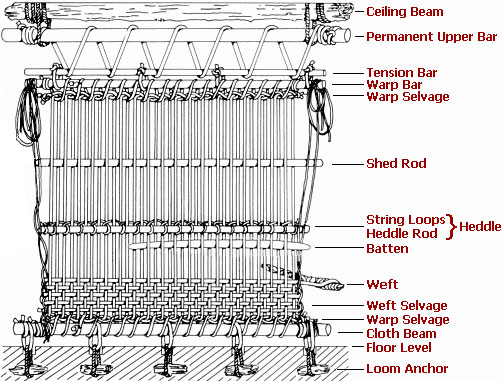
Upright Loom
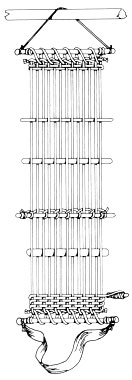
Backstrap Loom
|
Backstrap Loom
The backstrap loom was limited to the
production of narrow cloths, generally 18 inches or less in width.
Also called a waist, stick, or belt loom, this device consists
of two rods about 18 inches to 28 inches long, between which warps
are fastened. One rod is secured to a strap passed about the
weaver's waist as he sits. The other rod is fastened to a tree,
house wall, or even the weaver's outstretched feet. Warps may
thus rest parallel to the ground, but they usually slant slightly
to markedly upward from the weaver's waist. Wefts are inserted
beginning at the waist bar, and the finished cloth is wound about
this bar as needed to keep the unfilled warps within easy reach
of the weaver's hands. As in the case of the upright
loom, warps are controlled by shed rod and heddle, and wefts
forced down with comb or batten, in this case a small batten,
little wider than the web. The reed heddle used with the backstrap
loom by some modern Pueblo Indians is a Spanish introduction.
|
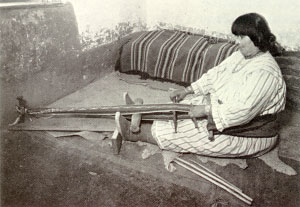 |
Stephanita
Herrera of Cochiti Pueblo with
a finished Navajo-style belt
on a backstrap
loom in 1935.
|
Narrow Upright Loom
(Used for making dance sashes.) Diagram of the Hopi brocade technique. For the sake of clarity,
the number of warps has been limited. (a) Brocade weft of colored
wool. (b) Tabby of very fine linen or cotton thread that interlaces
with warps in regular plain weave; in most sashes, the tabby
is inserted after each brocade weft rather than after every
two wefts as shown here. (c) Heddle for regular plain weave.
(d) Supplementary heddle controlling pairs of warps that will
be wrapped. (e) Shed rod for plain weave. 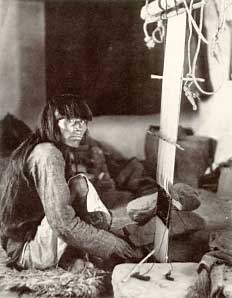
Hopi man weaving a sash, ca. 1898 CHS-4574. Courtesy of University of Southern California, on behalf of the USC Specialized Libraries and Archival Collections.
|
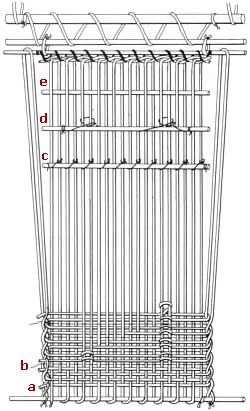 Narrow Upright Loom
Narrow Upright Loom |
|


